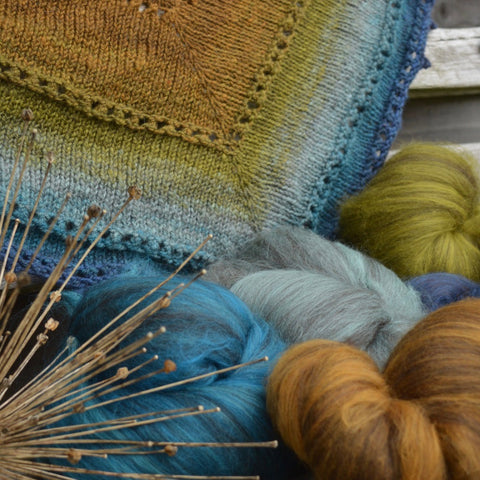Happy New Year!

I thought I'd blog a little "making" content here about the Haunui/merino batts as I'm adding just a few of my more popular colour-ways to this first update of 2019. I'm hoping to add to the range of colours so do keep coming back.
Over the past few years, I've developed a range of colour-ways in this cosy wool blend. To explain, these sets are 5 x 30g hand-carded batts of 35% Haunui New Zealand and 65% merino wools in five co-ordinating colours. The Haunui is around 26 microns (but feels even softer than that whilst being pretty durable due to its staple length). The merino is 23 microns and so the batts average the low 20s microns and are soft enough for most people for next to skin wear. It's a versatile blend for a range of spun, knitted and woven items as so many BarberBlackSheep customers have found with their gorgeous creations over the years. Both wools are excellent felting wools too (so take care with hand washing your finished items!) and these batts have been used extensively by some of my felt-making customers to make beautiful felt garments and art pieces.
"Still Waters" (shown above) was one of my early colour-ways and is still probably my overall favourite! As I was making up some for this shop update, I thought I'd do a little "focus" blog post to give ideas for anyone new to either Barber Black Sheep or spinning with batts.
As I design my colour-way recipes, some are created more with colour "gradients" or "ombré" in mind. Some are just colours I think that work well together and still others that are more contrasting with the idea of producing vibrant stripes or for colourwork knitting for mittens and hats or decorative yoke patterns to complement a garment knitted from semi-solid yarns.
For the colour sets that lend themselves more to gradients, however subtle the shading, there is always going to be an abrupt change where you switch from one colour to the next. To get around this, you do have to "smooth" out the colour progression as you spin it. There are some basic ways to do this by switching short sections between colours as you spin or by plying the last of one batt with the first of the next colour to even out the colour graduation. But for a really smooth colour graduation, you'll need to fetch the carders (or whatever fibre prep blending tool you prefer!) and do a little colour mixing yourself!
Almost exactly three years ago I wrote a comprehensive photo tutorial for my original Wordpress blog - this is linked under the tutorials menu that you can see just above this post at the top right. (For ease of reading I'll link it here in the text too though - Hand Carding Smooth Gradients)
Eventually I used the yarn I spun from these samples to knit myself a kerchief which is featured in the image at the top of this blog post - you can see how nicely the colours blend into each other. (The pattern is The Age of Brass and Steam which is a free pattern available via Ravelry.) Because I was carding this fibre purely for the photographs to illustrate the tutorial, I didn't make up the full 150g quantity that purchasers receive and I also chain-plied it to keep the colour progression. So this is a fairly small item although still perfectly functional.
But the regular 150g quantity should give you sufficient yardage to do a really sensible sized kerchief or small shawl, depending on the thickness of your spinning, especially if before you start the blending process, you divide each colour in half and do the blending in two sections so as to have matching singles to create a 2-ply yarn, rather than chain-plying. If you like fine spinning and create a light lace weight yarn then you can knit quite a generous lace shawl with these sets!
For new customers who'd like to know more about fabulous Haunui NZ Halfbred wool and the amazing farm and people behind it, there's also a blog post I wrote about it under the "info" menu above. The commercially dyed merino I use to complement the Haunui wool, is ethically produced in South America or South Africa from non-mulsed sheep and dyed to conform to Oeko-Tex 100 quality system.